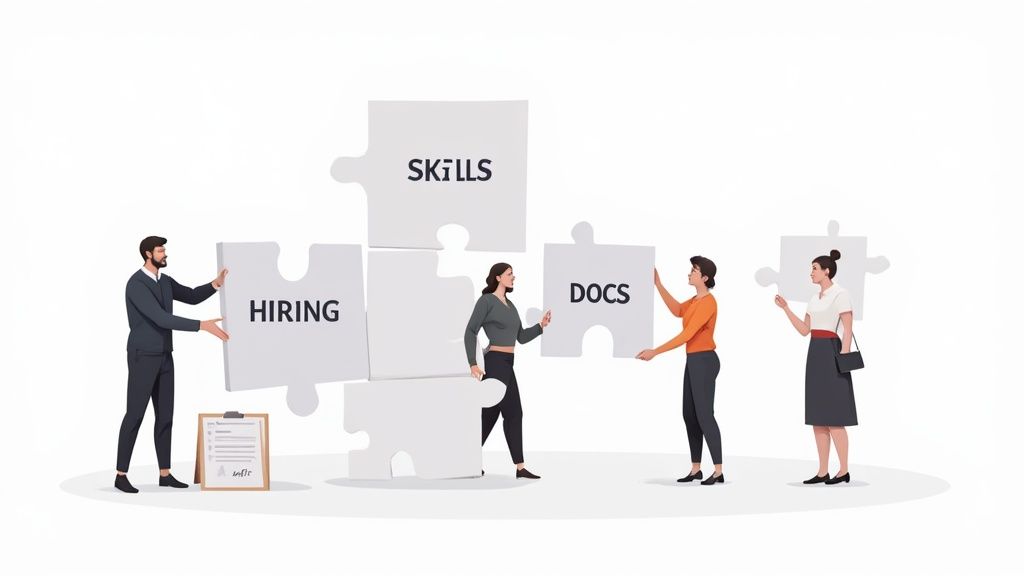Picking the right tech stack isn't just a technical detail—it's a foundational business decision. Get it right, and you're set up for a scalable, maintainable, and cost-effective product. Get it wrong, and you're looking at headaches down the road. The sweet spot is a perfect balance of four things: your project's needs, your team's skills, future growth, and the total cost.
Laying the Groundwork for Your Tech Stack

Before we start throwing around framework names, let's get on the same page about what a "tech stack" actually is. Think of it as the complete collection of technologies that work together to build and run your application. This includes everything from the front-end frameworks that create the user experience to the back-end servers and databases that do the heavy lifting.
Your front-end stack is what your users see and interact with. This might involve tools like React to build dynamic, snappy interfaces. If your team is already in this world, exploring different React frameworks can open up new ways to build slick, high-performing components.
Then you have the back-end stack, which is the engine under the hood. This includes your programming language (like Node.js or Python), a web server (like Nginx), and the database (like PostgreSQL or MongoDB) that handles all the business logic and data. These choices are what dictate your app's speed, security, and ability to grow.
The Business Impact of Your Tech Choices
Choosing a tech stack has real financial and operational weight. A good choice can seriously speed up development, while a bad one can lead to expensive delays and a maintenance nightmare. Understanding things like how long it takes to build a website helps put the resource and timeline planning into perspective.
This decision is huge, especially when you consider that stack complexity is a major hurdle for many companies. In fact, a staggering 70% of data leaders say their current stack is too complex, which often leads to wasted money. On the flip side, companies that nail this and adopt a modern, well-aligned stack have seen query performance jump by 70% and their total cost of ownership drop by 50%.
A thoughtful tech stack isn't just about picking popular tools; it's about building a sustainable foundation that supports your business goals today and prepares you for the challenges of tomorrow.
To make this decision less overwhelming, I find it helpful to break it down into four core pillars. This framework gives you a clear way to evaluate your options and make sure your final choice is both technically solid and strategically smart.
Key Pillars for Tech Stack Selection
This table summarizes the four core areas to evaluate. Use it as a checklist to guide your conversations and ensure you're covering all your bases.
| Pillar | Key Questions to Ask | Potential Impact |
|---|---|---|
| Project Requirements | What problem are we solving? What features are essential for the MVP? | Dictates the complexity, performance needs, and feature set of the application. |
| Team Expertise | What technologies does our team already know well? | Affects development speed, code quality, and the ability to troubleshoot issues. |
| Growth & Scalability | How many users do we expect in one year? Five years? | Determines if the stack can handle increased load without a complete rewrite. |
| Total Cost of Ownership | What are the costs for licensing, infrastructure, and hiring talent? | Influences the long-term financial viability and maintenance burden of the project. |
Thinking through each of these areas forces you to move beyond "what's cool" and focus on "what's right" for your specific situation. It’s the difference between building a product that just works now and one that thrives for years to come.
Matching Your Stack to Your Business Goals

It’s a classic trap: teams jump straight into heated debates about frameworks and languages before they’ve even defined the problem. Let’s be clear—the idea of a single “best” tech stack is a total myth. The right stack is the one that’s tailor-made to support your business objectives from day one.
This is all about translating your business needs into concrete technical requirements. Are you trying to ship a quick Minimum Viable Product (MVP) to see if an idea has legs? Or are you architecting a sprawling, enterprise-level platform meant to last a decade? The tech choices for these two scenarios couldn't be more different.
From Business Needs to Technical Specs
Before you even think about code, you need to do a practical assessment of what your application absolutely must do. Forget frameworks for a minute and focus on pure functionality. This simple step is your best defense against over-engineering and ensures every technical decision has a clear "why" behind it.
So, what does your app actually need to do?
- Real-time Interaction: Do you need things to happen instantly, like in a live chat app or a real-time analytics dashboard? If so, you're already leaning towards technologies like WebSockets and frameworks built for that kind of persistent connection.
- Heavy Data Lifting: Is your app going to be churning through massive datasets or running complex queries? This will heavily influence your database choice (think SQL vs. NoSQL) and the backend language you pick to handle the load.
- Fort Knox Security: Are you handling sensitive information, like financial data in a fintech app or patient records in healthcare? This demands a stack with a rock-solid security reputation and tools that make it easier to meet strict compliance standards like PCI or HIPAA.
- Connecting the Dots: Will your app need to talk to a bunch of external services and APIs? Your choice of language and framework will matter a lot here—you’ll want something with robust HTTP clients and a rich ecosystem of libraries for integrations.
Getting this down on paper is like creating a blueprint. It forces you to make decisions that solve real problems, not just chase the latest shiny object on Hacker News.
Seeing It In Action: Stacks for Different Goals
To make this tangible, let’s walk through two completely different scenarios and see how their business goals dictate their tech stack.
Scenario 1: The High-Traffic E-commerce Site
For an e-commerce platform, the name of the game is speed, reliability, and the ability to handle massive traffic spikes during events like Black Friday. The business needs a snappy UI, lightning-fast product search, and a bulletproof checkout process.
A smart stack here might look something like this:
- Front-End: Next.js for its server-side rendering capabilities. This gets pages to the user incredibly fast, which is a huge deal for both SEO and keeping impatient shoppers from bouncing.
- Back-End: Node.js is a natural fit. Its non-blocking, event-driven architecture is brilliant at juggling thousands of concurrent connections from shoppers browsing the site.
- Database: A hybrid approach often works best. PostgreSQL for critical transactional data (orders, user accounts) and something like Elasticsearch to power a ridiculously fast and flexible product search.
The takeaway? Every single piece of this stack is chosen to drive performance and a killer user experience. A slow site loses money, period. So, the tech is optimized for speed above all else.
Scenario 2: The Secure Fintech App
Now, let's flip the script. For a fintech app, the absolute top priorities are security, data integrity, and regulatory compliance. The business has to build trust from the ground up, ensuring every transaction is flawless and secure.
The stack here will prioritize a different set of strengths:
- Back-End: You'd likely see a language like Java (with Spring Boot) or C# (with .NET). These are battle-tested, mature ecosystems known for their robustness, extensive security features, and strong typing.
- Database: A traditional relational database like PostgreSQL is non-negotiable. Its strict ACID compliance is essential for guaranteeing that financial transactions are handled with perfect integrity.
- Architecture: A microservices architecture would be a strong contender. By isolating critical functions (like payments or user authentication), you limit the "blast radius" if one part of the system is ever compromised.
In this world, raw performance might take a backseat to bulletproof security and reliability. Choosing a "boring" but proven stack isn't a technical compromise; it's a strategic business decision. By putting your business goals first, you build a foundation that doesn’t just work—it succeeds.
Building on Your Team's Strengths and Expertise

Let's be real. A perfectly designed tech stack is just a theoretical exercise if your team can't actually use it to build, ship, and maintain your product. The most critical factor in your decision isn't the technology itself, but the people who will be living in that codebase every single day.
Starting with what your team already knows is almost always the fastest path to a successful launch.
When your developers are fluent in a language or framework, they hit the ground running on day one. They already know the common pitfalls, the best practices, and how to solve problems without losing weeks just getting up to speed. This isn't just about moving fast; it's about building a quality product that's stable for the long haul.
Conducting an Honest Skills Audit
Before you get swept up by the hype of a trendy new technology, you need to take a hard, realistic look at what your team can do right now. This isn't a performance review; it's a strategic gut-check to see where your collective strengths lie. A simple skills matrix can be incredibly revealing.
List out your key developers and the tech they know well. Then, start asking the tough questions:
- What can we build productively today? Pinpoint the tools your team can use to ship features immediately, without a massive learning curve.
- Where are our knowledge gaps? Be brutally honest about the tech where your team only has surface-level experience.
- What's our "bus factor"? If your one expert on a critical piece of tech leaves, are you completely stuck? Relying on a single person is a huge risk.
This audit helps you choose a path that builds on your team's existing momentum. For instance, if your team is packed with JavaScript experts, doubling down on a framework like React is a no-brainer. If they need to level up, our guide on how to learn React can give them a clear path forward.
The best tech stack is often the one you already know. Familiarity translates directly into faster development cycles, fewer bugs, and a more maintainable codebase.
The Value of a Mature Ecosystem
Beyond your immediate team, the broader developer community around your chosen stack is a resource you can't afford to ignore. A mature ecosystem provides a safety net that is invaluable when you inevitably hit a wall.
First, look at the quality and availability of documentation. When your team gets stuck, clear, comprehensive docs can be the difference between a ten-minute fix and a two-day investigation. A vibrant community also means more tutorials, conference talks, and forum discussions to pull from.
Finally, think about hiring. Choosing a popular, well-established technology like Python or Java means you have a much larger talent pool to draw from when it's time to grow. Opting for a niche language can turn a simple hiring process into a long, expensive hunt for a handful of qualified developers. This is a key part of choosing a tech stack that can actually support your long-term growth.
Planning For Growth, Scalability, and Cost

Choosing a tech stack is a lot like laying the foundation for a skyscraper. If you plan for a two-story building but suddenly need to support fifty, the whole structure is compromised. The ability for your application to handle its own success is baked in right from the start, deep in its core architecture.
This isn't just about handling a flood of new users; it's about how gracefully your stack performs under pressure. Key performance metrics like latency (the time it takes to process a single request) and throughput (how many requests it can juggle at once) are directly tied to your technology choices. A sluggish app doesn't just annoy users—it actively costs you money.
For some practical advice on this, we've put together a guide on how to improve website loading speed that’s packed with actionable tips.
Vertical vs. Horizontal Scaling
When you hit a growth spurt and need more power, you have two main paths to take. Your stack needs to be ready for the one you choose.
-
Vertical Scaling (Scaling Up): Think of this as swapping out your car's engine for a bigger one. You add more resources—like a beefier CPU or more RAM—to a single server to make it more powerful. It's often simpler to manage at first, but you’ll eventually hit a physical limit, and the costs can get eye-watering.
-
Horizontal Scaling (Scaling Out): Instead of one monster server, you just add more servers to the fleet and spread the workload across them. This is the bedrock of modern, cloud-native apps. It’s more complex to set up initially but offers almost infinite scalability and much better fault tolerance. If one server goes down, the others pick up the slack.
A monolithic application might scale vertically without much fuss, but a microservices architecture is designed from day one to scale horizontally. Figuring out which model aligns with your long-term vision is a huge piece of the tech stack puzzle.
Calculating The True Cost Of Ownership
The initial price tag for development is just the tip of the iceberg. What you really need to look at is the Total Cost of Ownership (TCO), which paints the full picture of what your stack will cost over its entire lifetime.
A stack that’s cheap to build can be a nightmare to run. You have to factor in everything: ongoing server bills, maintenance, licensing fees, and the cost of finding and hiring engineers with the right skills.
This is where a cloud-native approach really shines. Cloud computing has become the standard for modern applications for good reason—it’s cost-effective and incredibly flexible. As of 2025, around 51% of companies have moved their infrastructure to the cloud. Projections show that over 45% of all IT spending will shift to cloud services by 2026. This trend allows businesses to pay for what they use and scale on demand, all without shelling out for massive, upfront hardware investments.
Tech Stack Cost Comparison
When you're mapping out your budget, it's helpful to compare the financial implications of different stack philosophies. Each comes with its own set of trade-offs.
| Stack Type | Initial Cost | Maintenance Cost | Scalability Cost | Ideal Use Case |
|---|---|---|---|---|
| Open-Source | Low to None | High | Moderate | Startups, community-driven projects, custom solutions. |
| Proprietary | High | Low to Moderate | High | Enterprise applications needing dedicated support and SLAs. |
| Cloud-Native | Low (Pay-as-you-go) | Moderate | Low to Moderate | Scalable applications needing flexibility and resilience. |
| Headless/Composable | Moderate | Moderate | Low | E-commerce or content sites needing flexible frontends. |
Ultimately, choosing a stack that can grow with you isn't just a technical decision; it's a strategic one. It's about finding that sweet spot between today's immediate needs and tomorrow's biggest ambitions. A scalable, cost-effective stack is the engine that will power your business long after the confetti from your launch party has been swept away.
Adopting Modern Tech to Stay Ahead
Picking a tech stack isn't just about solving the problems you have right now; it's a strategic bet on where the industry is headed. A stack that feels cutting-edge today can quickly become a technical liability if it can’t keep up with major shifts like AI, machine learning (ML), and serverless architectures. Building an application that lasts means choosing tools that are not just functional but also flexible enough to adapt.
This is especially true with the explosion of artificial intelligence. Integrating AI is no longer a niche, "nice-to-have" feature—it's becoming a core part of building a competitive advantage. It's a massive wave; global spending on AI is expected to hit $360 billion by 2025, and 83% of companies now see it as a top business priority.
Just look at the impact: Netflix already pulls in over $1 billion a year from its AI-powered recommendation engine alone. That's real, tangible value. You can dive deeper into how AI is reshaping tech stacks over at SuperAGI.com.
Evaluating AI and ML for Your Project
So, how do you know if your project actually needs AI or ML? The first thing to do is cut through the hype and pinpoint specific, concrete ways these technologies can make your product better.
Start by looking at your data. Does your application handle a lot of it? If so, you're sitting on a goldmine for AI-powered features.
- Predictive Analytics: An e-commerce app could use ML models to predict inventory needs based on sales trends, preventing frustrating stockouts or costly overstocking.
- Automated Personalization: A media site can create a completely unique experience for every visitor, recommending articles or videos based on their viewing history. This is a game-changer for engagement.
- Intelligent Automation: Think about your internal tools. AI can automate tedious tasks like routing support tickets or flagging suspicious account activity, freeing up your team to focus on work that actually requires a human brain.
Building with AI/ML support in mind is a form of future-proofing. It gives you the runway to add intelligent features later without having to tear down your entire architecture and start over.
Selecting AI-Ready Frameworks and Platforms
Once you have a solid use case, the next step is finding the right tools for the job. You don't need to build everything from the ground up. The smart move is to pick platforms with a mature ecosystem for AI and ML.
Look for languages and frameworks that are known for their powerful AI/ML libraries. Python is still the undisputed king here, with giants like TensorFlow and PyTorch powering countless applications.
On the infrastructure side, cloud platforms like AWS, Google Cloud, and Azure are your best friends. They offer a whole suite of managed AI services that you can plug directly into your application. They handle all the heavy lifting of training and deploying models, so your team can stay focused on building great features.
Ultimately, the goal is to build an adaptable architecture. By planning for these advancements from the start, you create a stack that doesn't just meet your immediate needs—it gives you the flexibility to innovate and stay ahead for years to come.
Answering Your Biggest Tech Stack Questions
Even with a solid plan, you're going to have questions. It’s only natural. Making the final call often boils down to a few practical, real-world concerns that pop up right when you’re about to commit.
Let's walk through some of the most common questions I hear from teams on the verge of picking their path.
How Often Should I Review My Tech Stack?
A tech stack is a living thing, not a "set it and forget it" decision.
Think of it this way: give it a lightweight check-up once a year, and a full, in-depth audit every two to three years. The annual review is your chance to patch security holes, update critical libraries, and grab any easy performance wins.
The deeper audit is where you ask the tough questions. Is our stack actively slowing down feature development? Are we bleeding money on maintenance? Could a newer tool solve our core problem 10x better? This doesn't mean you have to rip everything out and start over. More often, it leads to a smart, phased migration of one or two services.
What Is the Biggest Mistake to Avoid?
Easy. The single most expensive mistake you can make is "resume-driven development."
This is what happens when someone on the team picks a shiny new technology because they want to learn it, not because it's the right tool for the job. It's a trap. You end up with a system that's wildly over-engineered for what you actually need.
Worse, you now have a system that’s hard to hire for and has a tiny support community when things inevitably break. Always, always tie your tech choices back to the business goals. The "boring" but stable and well-understood technology is almost always the smarter bet, especially for your core product.
The best tech stack solves your business problem with the least friction. It’s not the one that looks coolest on a resume.
Should I Choose a Monolith or Microservices?
This really comes down to your team size, the complexity of your project, and where you see it going long-term.
For most startups and MVPs, a clean, well-organized monolith is the way to go. It’s faster to build, simpler to deploy, and lets a small team move at lightning speed without getting bogged down in operational overhead.
But as your application—and your team—grows, that monolith can start to feel like a ball and chain. That's the moment to start thinking about microservices.
- Microservices give you incredible scalability, let teams work independently, and offer the flexibility to use different tech for different jobs.
- But don't be fooled—they also bring a ton of complexity with deployment, monitoring, and keeping data consistent across services.
My best advice? Start with what some call a "majestic monolith." Build a single application, but design it with clear, logical boundaries inside. Only when you feel the real pain points that microservices solve should you start breaking pieces off.
Choosing the right components is the first step, but building with them is what brings your vision to life. At Magic UI, we provide over 150 free, open-source animated components built with React, Tailwind CSS, and Framer Motion to help you build beautiful and performant UIs faster.
Explore the collection at magicui.design.
